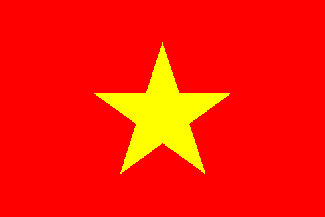
Coming from the airport, the traffic and shops of Saigon looked familiar. Note the proportion of scooters, however. Note the crosswalk -- it is only a fantasy. The traffic continues in an unending stream. I was quickly taught how to cross streets: pedestrians step out into the traffic and walk slowly and deliberately across. Traffic moves slightly to the right or left to avoid them. It is like walking through a school of fish, they simply flow around the people on foot. But...this doesn't work so well with cars and especially busses!

Seen from the hotel, Saigon -- Ho Chi Minh City -- has a modern skyline.

Though it has a dynamic market economy, one is never far from a reminder that Vietnam is a Communist country

We stopped at a shrine commemorating Thich Quang Duc, the Buddhist monk who burned himself with gasoline on this corner as a protest of the South Vietnamese government's anti-Buddhist policies. From left to right -- Bob Cagle, Jim Helt, Ed Tick, Beth Marie Murphy, Bill Keyes, Lynn Kohl, Thomas Greving, Jack Day, local child.

We lit incense on behalf of those on each of our minds.

South Vietnam's former Presidential Palace, now called Reunification Palace

The Palace now flies the flag of reunified Vietnam.

The North Vietnamese tank that was first to enter the Presidential Palace grounds on April 30, 1975.

The South Vietnamese airplane that was flown from Danang on April 8, 1975, after Danang's fall, to bomb the Presidential Palace. The South Vietnamese flag on the tail of the plane is the only time this flag was ever visible during our trip to Vietnam--and it has an x marked through it! In the view of Vietnam today, the South Vietnamese government was a puppet government of Vietnam's enemies, and reminders of its existence are an embarassment or an offence. Leaders of Vietnam Veterans of America, whose logo incorporates the South Vietnamese flag, were asked to have their calling cards in Vietnam printed in black and white so that the yellow and red South Vietnamese flag in the logo would not be so apparent.

On the roof is a helicopter pad used by South Vietnamese Presidents; a commemorative helicopter marks the spot. In the foreground is a note describing where the Palace was bombed on April 8, 1975 by the plane shown above.

In the basement war rooms of the palace are maps and tables. This map shows the Ho Chi Minh trail in black.

This table gives the troop strength of those arrayed against the North, at its peak in 1968. I am pointing to the figures for the Army.

Most tourist itineraries include a stop at the War Remnants Museum. It used to be called the War Atrocities Museum, and still contains displays reciting the damage caused to people and property by the war. Exhibits include some American aircraft, many photographs, and a replica of the infamous Tiger Cages where the South Vietnamese held Viet Cong prisoners.
What caught my attention, however, was that the accounting of terrible things the Americans had done was bracketed by exhibits before and after which suggested the desire for good relations. Before the war, pictures displayed the working relationship between Ho Chi Minh and the Americans against the Japanese in World War II. After the war, pictures displayed American notables visiting Vietnam and discussing the past with their former enemies. In all, I got the impression that what they call "The American War" was to present-day Vietnamese, an aberration from and a betrayal of an otherwise desirable and good relationship.

There is a war surplus market place at which American uniforms and other relics of the war are still for sale.
Home Page | Vietnam Chaplain | Central Highlands Diary | VVAW | VVA | NCVNVM | The Wall
Return to Vietnam | Ho Chi Minh City | Mekong Delta | Kontum, Dak To, Ben Het | Pleiku
Danang | Hue | DMZ and environs | Hanoi and Ha Long Bay | Album | Poetry

